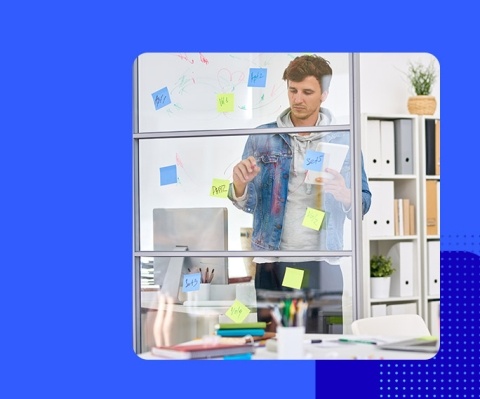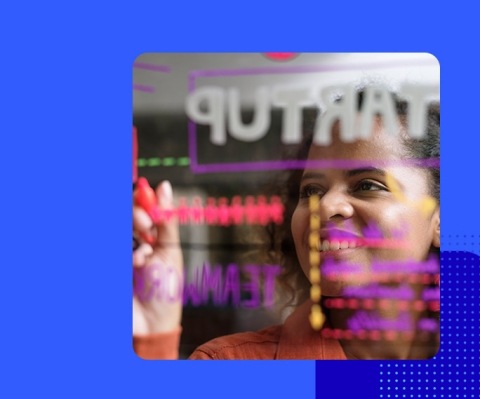The startup's guide to user feedback

It’s hard work starting a company in an increasingly competitive and global marketplace— especially when that marketplace can face operational threats ranging from the economy to the weather.
So, it may not be such a surprise to learn that most startups and small businesses will ultimately fail.
But that fate is not predetermined. You can improve the odds of your startup’s success by talking with your customers and making sure they believe in your product or service offering as much as you (and your mother) do.
Don’t believe us? Consider these UserTesting customers who went from startup to successful acquisition:
- Dollar Shave Club: acquired in July 2016 for $1 billion by Unilever
- Giphy: acquired in May 2020 for $400 million by Facebook
- Teachable: acquired in March 2020 for $250 million by Hotsmart
And the list doesn’t end there. More than a dozen other startups—all UserTesting customers—went on to be acquired for more than $24 billion combined. That’s billion with a B.
What user feedback can do for your startup
Ensuring you understand your customers’ expectations allows you to identify and remedy small problems before they have the chance to become critical issues down the line.
User feedback will:
- Improve product quality
- Build trust with consumers
- Save money and other precious startup resources
And if you haven’t guessed already, there’s no better way to understand what your customers need than by asking them. This holds true for those startups in beta or in “stealth mode,” too.
How to use this guide
In this resource, we’ll share why it's important for startups and small businesses to seek user feedback, explore how you can use those human insights, and outline ways to collect it through user feedback. And, throughout, we’ll show you how UserTesting may help.
What's inside
The #1 mistake startups make

Startups and small businesses are the backbones to a healthy economy, whether you’re based in Paris, Texas or Paris, France.
Startups create more jobs, spur innovation, and inject competition, all of which improve local and regional economies. Consider the impact Alibaba has had on Hangzhou, China; Microsoft on Redmond, Washington; and Google on Mountain View, California. All were once small startups.
But not all startups will follow the same path.
CB Insights, the tech market intelligence platform, dug into the data on startup failures and found that 70% of upstart tech companies fail within the first two years.
No market need
Poor usability
Ran out of cash
Many of the top reasons why startups fail align around some aspect of product-market fit. Founders start a company because they see a problem that needs to be solved. But does your product really address a core problem that an audience has, and do you know who that audience is? And how do you execute against that?
The idea of product-market fit is widely attributed to entrepreneur and investor Marc Andreessen, who has invested in a who’s who of the web. As he says, in many cases, it's not that you haven't found a problem worth solving. The issue is that your solution is not compelling enough for people to switch. You have to build products that are ten times better than the current offering for people to make the switch to your product. User feedback gives you the evidence they will switch (or not).
During a recent conversation on the Clubhouse social audio app, Andreessen talked about how companies looking for Series A funding aren’t doing enough if any, testing and that he wouldn’t touch any company as a potential investor that hasn’t actively tested their product-market fit. “This strategy worked after our Seed round” isn’t enough to Andreessen Horowitz, Andreessen said.
Paul Graham is the cofounder of Y Combinator, the startup accelerator that has invested in more than 3,000 companies with a combined valuation of $300 billion since its founding in 2005. He was once asked why so many small businesses fail. In a blog post, he said it was a good question because “if you have a list of all the things you shouldn't do, you can turn that into a recipe for succeeding just by negating.”
For him, it funneled down to one mistake.
“In a sense, there's just one mistake that kills startups: not making something users want. If you make something users want, you'll probably be fine, whatever else you do or don't do. And if you don't make something users want, then you're dead, whatever else you do or don't do.”
 Paul GrahamCofounder of Y Combinator
Paul GrahamCofounder of Y CombinatorIn a sense there's just one mistake that kills startups: not making something users want. If you make something users want, you'll probably be fine, whatever else you do or don't do. And if you don't make something users want, then you're dead, whatever else you do or don't do.
Two other reasons startups fail: building a product that users can’t figure out and running out of cash—both directly connected to user feedback. Quick tests with prospective buyers using wireframes or prototypes during development will help you both determine whether your product is user-friendly, and also help avoid costly engineering rework if it doesn’t.
Professor Jeffrey Liker, who has spent years studying and documenting “The Toyota Way'' explains the philosophy like this: “You cannot be sure you really understand any part of any business problem unless you go and see for yourself firsthand.”
There’s no formula here. Just do whatever you can to better understand your users.
In today’s modern world, it’s no longer a question of can this be built (and hope they’ll come) but rather, this should be built because we’ve talked to our target audience and they’ve told us they’ll come.
How UserTesting customers are doing it
Notre Dame
The Notre Dame IDEA Center works with faculty, student, community, and alumni entrepreneurs on their commercially viable, early-stage product ideas and innovations. The startups that go through the program use UserTesting to answer four key questions:
- Does the product or service idea work?
- What is the problem they are solving?
- Does anyone want to buy it, and who?
- And are they going to love using it?
“The benefit that I get out of UserTesting is I get to figure out really quickly, at a really early stage, whether an idea has legs or not,” said Ben Hoggan, the center’s Director of De-Risking.
Collectively in 2019, the 64 companies that have gone through the IDEA Center reported raising $6.6 million in investment and generating $10.9 million in product sales, a 584 percent year-over-year increase from 2018.
 Ben HogganDirector of De-Risking at Notre Dame's IDEA Center
Ben HogganDirector of De-Risking at Notre Dame's IDEA Center“The benefit that I get out of UserTesting is I get to figure out really quickly, at a really early stage, whether an idea has legs or not,”
Indeed
The Indeed Startup Incubator was created to help the company continue to innovate around its mission to help job seekers. Teams within the product accelerator operate like mini-startups building new products and assessing their viability through fast launches and empirical learning.
Indeed is a very data-driven organization, but the new products within the Incubator program are so small that teams often can't rely on quantitative data alone to validate a hypothesis. So, they needed a way to quickly get qualitative data to inform product ideation.
As part of its kick-off week (a modified design sprint), Incubator teams leverage UserTesting’s Live Conversation to set up calls for the team to chat with users before they begin defining their solution.
The Indeed Incubator has funded 34 products since 2017, with at least six exiting into the main organization.
The 7 ways user feedback powers your startup

So how can you take advantage of user feedback for your startup? Let’s start by defining what user experience (UX) research is and why it’s important.
Traditionally, UX research is the practice of studying user interactions to help with the design of people-first products and experiences.
But customer research can vary depending on whom you’re talking to. For product teams, UX research might mean validating prototypes and concepts. For marketing teams, it may mean testing brand designs and messaging before a launch. In other words, UX research is no longer a practice held in one corner of the business.
The most successful organizations empower all teams to collect user and customer insights in order to make better business decisions.
Let’s take a look at how you can use user feedback in your startup and small business:
1. Product-market fit
Just because you’ve designed a product that provides a solution doesn’t mean there was ever a problem to begin with. So achieving product-market fit is important because, without it, you run the risk of building a product that no one actually needs. Hint: stop beta testing with yourself, friends, and family and go out and talk to customers and potential customers.
Doing your research upfront will save you from designing a product that no one needs. You’ll even find opportunities along the way for your product to solve problems you may have never even considered. By ensuring product-market fit, you’ll increase speed to market by knowing exactly how to address the unique needs of your prospective customers.
Product-market fit doesn’t happen by magic. Learn more in this blog post, How to achieve product-market fit before you design anything.
2. Evaluate concepts
No matter what you’re creating, prototype testing can—and should—happen early and often in your development cycle.
When it comes to prototypes, you can test anything. Have an idea on a cocktail napkin? Test it. Not sure about product-market fit? Try it out on your target audience first. If ever there should be a cardinal rule to creating great experiences, it would be to test first, design and build after, then test again.
Prototype testing enables you to assure that your design is going in the right direction and that you address any essential features or flaws before you write even one line of code.
Redesigning a prototype is a lot easier—and less expensive—than reworking a finished product. You’ll save your budget and your sanity by testing right from the start. For example, Rothy’s had a 90% improvement in engineering time and costs with testing and user feedback.
Prototype testing can also accelerate your growth because fast feedback from user feedback enables teams to iterate within hours instead of weeks. And that’s a big deal for startups and small organizations typically operating with small budgets and small teams wearing many hats.
In fact, Forrester's Total Economic Impact analysis revealed the average ROI from a UserTesting subscription over three years is 665% across composite companies, and showed an average payback period of fewer than three months. This is because development cycles are reduced by 2 weeks on average, while online conversion rates improved 60% with a 140% lift in average annual customer spend, according to Forrester.
Learn more by reading our blog post on 31 prototype testing questions every designer should ask.
3. Customer journey
Lots of teams map the customer journey in order to develop empathy for the customer. It helps them keep the customer’s needs and intentions at the center of their marketing and design decisions.
Building a customer journey map is an amazing exercise to help your startup or small business. Going through the project, you’ll be able to:
- Break down the phases of customer engagement
- Spot your customers’ pain points and empathize with them
- Determine together, as a company, what can and should be done to minimize any bumps in the customer’s journey
Check out The no-nonsense guide to mapping the customer journey to learn more.
4. Uncover creative use cases
A customer insights study will help you find unusual use cases that can spark innovation for marketing campaigns and product development.
For example, if you’re marketing an existing product, you can find out:
- What words your target customer would use to describe your product or your brand
- How they would describe your competitors
- Why they prefer one company over another
- The context for how they use your product
See it in action in this post where we undertook a customer insights study on people who make coffee at home.
5. Demographic trends
If you’re trying to uncover trends in how customers of different demographics interact with your product or your brand, you can run the same study with different segments.
For example, to compare how men and women view your product differently, you might choose to run two separate studies: one each, with 10 men and 10 women. This would make it easy to compare results from the two demographics. You might even be surprised by how your product or experience resonates with one demographic over another.
6. Competitive insights
Did one of your competitors just unveil a hot new product or feature? Before you rush to follow in their footsteps, you can do some exploratory research to see how consumers interact with the product—especially any potential dislike they have while using it. This can be a great opportunity for you to frame your product as the solution to that unmet need.
Honestly, if you aren’t testing your competitors’ website and app, you’re missing out on a golden opportunity. Find out, in your users’ own words, why someone likes (or dislikes) a competitor’s offering over yours.
Stay ahead of the pack by analyzing your competition's strengths and weaknesses to devise winning strategies.
7. Messaging/Positioning
Marketers can leverage customer research to validate a huge array of marketing content—everything from commercials to images to email messages. It can also help you get inside the heads of customers on a wide variety of topics, even sensitive subjects like religion and politics. Everyone from the social media manager to the direct mail team should be listening to customers to understand what’s relevant to them. If you want a fast path to empathizing with your customers, this is it.
Check out how the nonprofit CaringBridge tests marketing videos. And here are the 5 top studies run by successful marketing teams.
How UserTesting customers are doing it
Trussle
Trussle is the UK's top-rated free online mortgage broker. They incorporate the UserTesting platform to gain critical insights throughout their content and product design process.
In our Espresso Webinar Series, Content Designer Alysia-Marie Annett and Senior Product Designer Anabella Volpi discussed how they conduct research at a startup.
Annett said she uses user feedback for sentiment testing, brand research, competitor research, views on their Fintech industry, and dialing in on the brand’s voice and tone.
“We use the platform quite a lot for everything from brand research to information architecture,” Volpi said. She continued on to mention that every project and company is different and only you will know when each research study is needed. “But my advice is no matter what, always put time in your roadmap for carrying out research.”
 Anabella VolpiSenior Product Designer at Trussle
Anabella VolpiSenior Product Designer at Trussle“We use the platform quite a lot for everything from brand research to information architecture. My advice is no matter what, always put time in your roadmap for carrying out research.”
Cedar
To better serve their customers, Cedar wanted to understand the unique needs and problems patients were facing outside of the moments they were using Cedar's product.
Cedar’s team, however, faced several challenges as they embarked on the quest to collect this information. To start, Cedar’s small design team already lacked the time and resources traditionally necessary to conduct a study of this size. And with COVID-related social distancing guidelines in place, the company also had to determine a way to safely interview customers and do so in a way that respected their privacy and current circumstances.
“UserTesting solved all these challenges for us. With the help of the new COVID-19 templates, we were able to quickly create two tests around the impact of the pandemic on healthcare billing and healthcare checking,” says Diana Ye, Product Design Lead.
With these solutions in place, Cedar’s team was able to streamline the data collection process by conducting interviews, collecting video content, and surveying customers all in one video session.
Your.MD
Your.MD connects real people with top physicians. The company wanted to enhance its user interface (UI) and UX to strengthen their product. The team decided that using a recruitment agency to acquire testers for their demographic was too time-consuming. Especially when the product team needed quick validation across multiple app features.
Your.MD brought UserTesting into their process to reach their key demographic and gain insights into their Symptom Checker and particularly to verify a UI prototype.
Your.MD gained crucial insights to inform their design concepts quickly, which meant the team was able to meet their deadline for going to market. They discovered their initial concept didn’t resonate strongly with their target audiences and were able to reevaluate based on these vital insights.
"UserTesting has given us invaluable, instant insights into our customers," said Justin Berkovi, Chief Product Officer of Your.MD.
Don’t guess, just test

As Steve Blank, the father of the lean startup, says, “No facts exist in the building, just opinions.”
Christian Idiodi, a partner at Silicon Valley Product Group, will add on to Blank’s quote, “And the best way to build your products is to find the problem you want to solve and spend time with the person you've identified that has the problem, which we call the customer. And you stick with them until you solve the problem.”
 Christian IdiodiPartner at Silicon Valley Product Group
Christian IdiodiPartner at Silicon Valley Product GroupWe have to test that what we've built is actually valuable. We have to test that people can use it. We have to test that it works for our business. We have to test that we know how to build it. Don’t guess, just test!
Test early, test often
A lot of founders and startup teams want to wait to test until they’ve finished the product’s development. That is not a good idea. In a study of 391 teams that designed custom integrated circuits, researchers found that teams that followed an iterative approach and conducted early and frequent tests made more errors along the way. But because they used low-cost prototyping technologies, they outperformed (in terms of the time and effort required) teams that tried to get their design right the first time. The teams that faced high prototyping costs invested more effort on specification, development, and verification. And because they did their iterations later in the process—and did far fewer of them—they delayed the discovery of critical problems.
Surprisingly, it doesn’t require a huge investment of time or money to carry this out successfully. Nielsen Norman Group discovered that a study with five participants will uncover 85% of the usability problems.
In his Don’t Guess, Just Test presentation at UserTesting’s 2020 HiWorld, Idiodi reviewed several different ways startups and small businesses can test their products and solutions. For example, have you heard of the Wizard of Oz test? Watch his video as he explains the Wizard of Oz test that Zappos executed in its early days as a startup.
By leveraging usability testing, you’ll have the ability to methodically test and validate your product’s product-market fit, user experience, and marketing collateral. By collecting customer insights at every stage of your product’s development, you won’t have to guess what your customers want, need, and frankly have come to expect.
And all of this can be done with a team of one if that’s what you’re working with. In fact, you’ll be able to accelerate your testing and decision-making with the ability to:
- Quickly recruit and schedule discovery interviews and usability tests
- Accelerate development sprints through instant feedback so you can iterate in hours or days instead of weeks
- And swiftly settle internal design and UX disputes by using qualitative proof directly from your prospective customers
“Remember, you are not your customer,” Idiodi said. “You must validate your ideas with actual customers. No matter how long you've been in the business, no matter how much data you know, you must test with the people you're trying to solve a problem for.”
So when should you get that fast feedback and how do you do it? Let’s explore how user research helps in each stage of your product’s development:
Discovery
During the discovery phase, you’re looking to better understand your customers. This can entail identifying and getting to know different personas or understanding high-level pain points. At this stage, you don’t have a product idea or an endpoint in mind. You’re at a starting stage and in search of clarity on areas of opportunity.
Prototyping
When you have some early sketches or designs, get feedback to validate usability before investing resources to build it out. Does the design make sense? Is it clear and intuitive to the user? And if you find out that something in your early designs is really problematic, you can change it and then test again to see if it’s a better experience before proceeding to development or production.
Development or prior to launch
Get feedback as you reach each milestone to ensure that you end up where you planned. And if feedback indicates there’s a problem or something that requires attention, you have the opportunity to fix these issues before proceeding to the next milestone. Studies have shown that problems that are discovered and fixed after a product release have 100x the cost compared to when issues are identified and addressed while in development.
Post-launch
Even after a new feature, product or campaign has launched, you’ll want to keep monitoring to address problems or to keep evolving the experience to drive greater adoption or conversion. For example, you may wonder, “Why are people dropping off at this stage in the workflow?” You can understand why this is happening by gathering qualitative insights.
Get more insights and examples with our ebook: Testing at every stage of the design process.
Gina Dematteo, Rothy's product designer, said it’s important to prioritize your resources and where you want to spend your time and money, and where that work needs to go in order to create a product that users actually want. Do away with the “gut feeling” decisions, she said.
How to plan, conduct, and analyze your customer studies
Now that you know what to test for during each stage, how do you set up your tests? That could be its own ebook—wait, it is an ebook: The complete guide to user testing websites, apps, and prototypes. Below is a quick outline for setting up a test.
- Define your objective. What are you trying to learn? Read this post about 20 questions every product manager should ask for some examples
- Determine the test you’ll need to get your answer
- Define your audience
- Create your test
- Perform the test
- Analyze the results
- Share the results
A well-planned and well-executed user study will uncover actionable, qualitative data that your team can use to make faster, better decisions.
How UserTesting customers are doing it
Eargo
Hearing loss in the US affects one in six adults, and one-third of all Baby Boomers. And an estimated 360 million people worldwide suffer from some form of hearing loss. But many consumers hate the idea of having a hearing aid. For them, it represents growing old.
Eargo is trying to reach those consumers who aren't addressing their hearing loss. “We have this incredible barrier that we have to overcome,” said Shiv Singh, CMO. “And the way we do it is by really focusing on every pixel, every frame, every punctuation mark in all of our communications. That's where UserTesting plays such an incredible role.”
Eargo runs UserTesting studies on everything, whether on their website or mobile app. “We don't launch stuff that hasn't been user tested and adjusted based on the feedback that we've gotten from our users,” said Singh.
He then takes video clips from the tests and shares them with stakeholders throughout the company. That has helped get 100% buy-in throughout the organization, enabling the team to use testing feedback to quickly evaluate, validate, and iterate on features that will impact revenue and conversions.
“What we like about UserTesting is literally the hundreds of tests that we can trigger again and again. Every time we run UserTesting, we learn something surprising and interesting,” said Shiv Singh, CMO.
Skyscanner
Skyscanner is a leading travel company dedicated to putting travelers first by making booking trips as simple as possible. Within 90 days of the onset of the 2020 pandemic, entire industries found themselves in a catastrophic fight for survival, few more so than the travel industry.
Oli Mival PhD., Director of User Research at Skyscanner and Principal Research Fellow at Edinburgh Napier University's Centre for Interaction Design, knew that Skyscanner would need to innovate and adapt like everyone's livelihoods depended on it—because travel had fundamentally changed.
“We got a sense of the scope and scale of things from our pulse surveys, but it was critical to have richer human insights from UserTesting to gain empathy and understand what we were seeing in the numbers. So, from the middle of March, we began speaking to 20 travelers from across the world every other week,” Mival said. “UserTesting was and continues to be our core platform for understanding what people in, say, South Korea are thinking, or Brazil, China, India, Germany, etc. It was really important to us that we had a global perspective, so that we weren’t being too UK-centric. Without UserTesting, that would have been nearly impossible.”
Canva
The idea for Canva came from watching non-designers trying to use traditional design tools. After years of development, the Canva team had built the first version of their product in late 2014.
The inevitable challenge with launching a product for the first time is not having seen how people would actually use it. So they engaged UserTesting to conduct some exploratory research and discover where they could make improvements. The insights were extremely useful.
Based on what they learned, the Canva team optimized their onboarding experience—paying particular attention to their users’ emotional journey—in order to dispel people’s beliefs that they didn’t have the talent, skills, or creative ability to design.
These improvements to the user experience played an important role in helping customer onboarding as the company grew to more than 10 million users in just a few months.
"UserTesting helped us understand what our users needed on both a UX and emotional level," Melanie Perkins, founder and CEO.
How startups succeed with UserTesting

Getting started on user feedback can be done with just a smartphone or a free online survey. But using a platform like UserTesting has some additional benefits. Let’s explore some of those additional resources you’ll get with UserTesting.
Templates
UserTesting has developed a number of Templates that you can use to tackle a variety of objectives, from discovery to validation. Additional templates have been developed that focus on COVID-19 and racial equality. Using these templates as a starting point can save you a substantial amount of time as well as ensure that you start with a robust approach.
Learn more about how Templates speed up your user feedback.
UserTesting University
Take advantage of virtual instructor-led and on-demand courses at UserTesting University. Once there, you can pursue user certification programs, participate in small group workshops, or get your specific questions answered during office hours.
See what’s new with UserTesting University.
CommUnity
The UserTesting CommUnity serves as an interactive customer engagement hub to ask and answer questions, share best practices, network with peers, and find inspiration. The UserTesting CommUnity includes weekly challenges that create a fun and competitive environment for participants that gives them the opportunity to earn rewards and new status levels every week.
Success stories
Stories help us learn and we have a wealth of customer success stories available to inspire you, give you ideas, or show you how someone else solved a similar problem you’re trying to tackle. You can search our customer success stories by industry, company size, roles, customer type, and region. See if one inspires you.
Conclusion

We're living in interesting times. Consumer behavior, sentiment, and expectations are evolving rapidly. Startups and small businesses that understand their customers, meet their needs, and provide a valuable experience will succeed.
Whether it’s a physical product or a digital experience, you’re more likely to meet—and exceed—customer expectations if you consider customer feedback throughout the product or campaign ideation, development, and optimization process. That way, in every step of the process, you’re creating solutions and experiences that match what your customers are seeking.
The question you want to ask yourself is whether you want to be among the 70% of startups and small businesses that fail? Or do you want to join those startups—like those in the video above—that believe in the power of testing, and let results speak for themselves.







